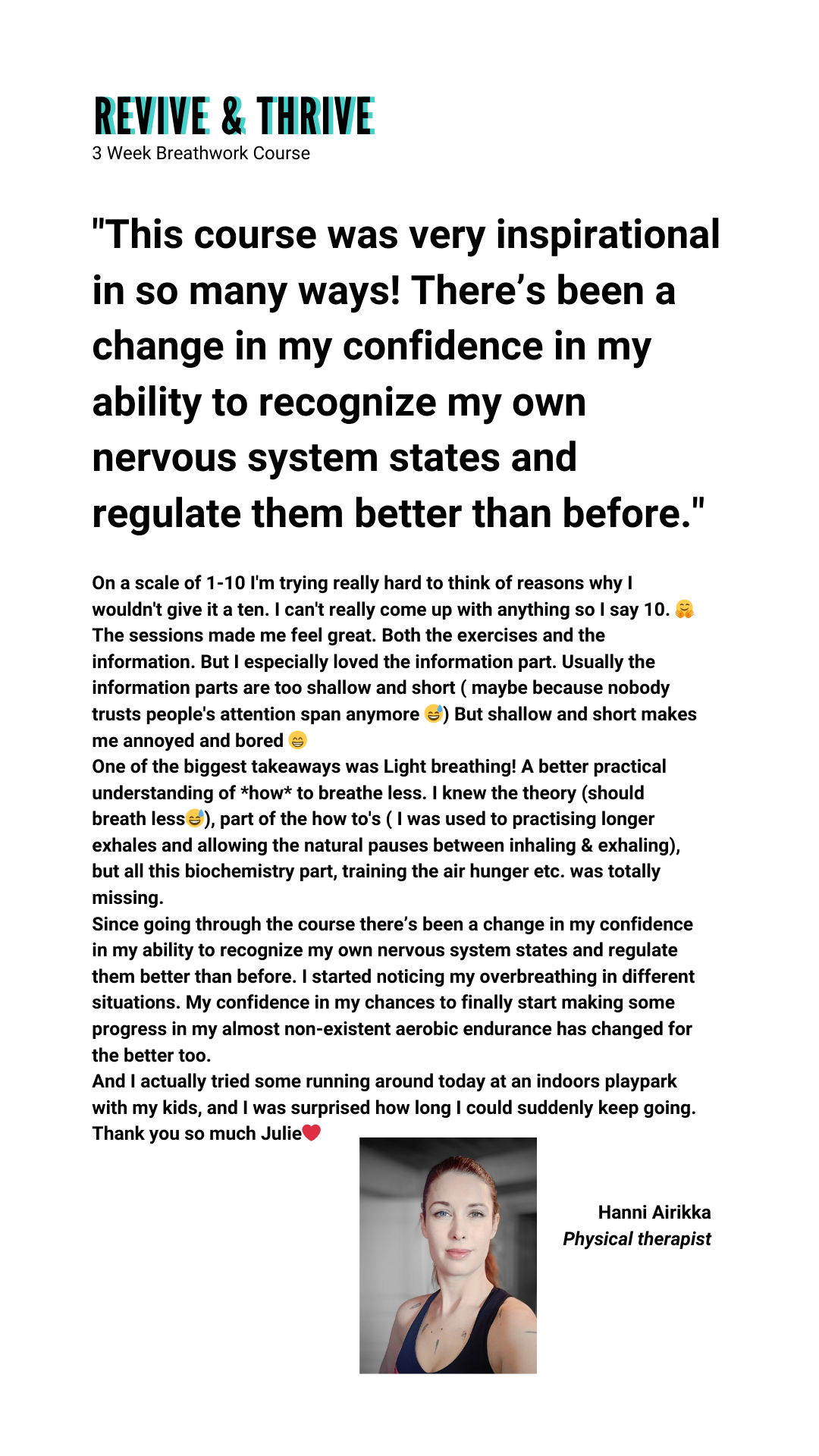The Benefits of Functional Breathing
Breathing is an intrinsic function we perform unconsciously most of the time. However, how we breathe can significantly impact our health, particularly in managing anxiety, menopause, sleep, and overall well-being. Recognizing and correcting breathing patterns can be life-changing.
75% of people who suffer from anxiety have dysfunctional breathing patterns.
Signs of Dysfunctional Breathing:
- Taking big breaths
- Breathing too fast
- Upper chest breathing during rest
- Irregular breathing
- Mouth breathing
- Sighing and frequent yawning
- Tingling hands and feet
- Cold hands and feet
- Waking up during the night to pee
When we see someone who is very stressed, they are often fast breathing with an open mouth.
Effects of Dysfunctional Breathing:
Dysfunctional breathing can affect every cell in our body, leading to symptoms such as:
- General fatigue
- Poor concentration and impaired memory
- Disturbed sleep
- Cardiovascular issues
- Muscle pain, soreness, cramping, stiffness
- Digestive problems like heartburn, hiatus hernia, flatulence, bloating, abdominal discomfort
- Dizziness, headaches, migraines, numbness in the hands and feet, hot flashes
- Anxiety, tension, panic attacks, phobias
- Slow metabolism and weight gain
Asthma, anxiety, panic attacks, and stress negatively influence our breathing patterns, creating a feedback loop of insufficient breathing.
The Benefits of Correcting Breathing Patterns
Functional breathing is about the balance of oxygen and carbon dioxide (and the presence of nitrix oxide)
Every cell in our body needs 2 things – glucose and oxygen.
Increased Energy
Optimal oxygenation helps the body access energy from food, motivating healthier habits and making change more achievable. When oxygenation is optimal, your body can access the energy from the food you eat. As you spend more time focusing on a breathing practice, you will notice you’re motivated to change other habits for healthier alternatives too. Change takes more energy than maintaining the status quo, so if we want to move more yet always feel too tired, unmotivated, and weighed down with the stresses of the day, it feels even harder than it could.
Better Focus and Concentration
Functional breathing breaks the feedback loop of anxiety and stress, enhancing focus and mindfulness. This is why mindfulness doesn’t work for people who need it the most, as they are caught in a feedback loop because anxiety, panic attacks, and stress all negatively influence our breathing patterns and feedback into a vicious feedback loop of insufficient dysfunctional breathing.
Improved Brain Health and Blood Flow
Better breathing leads to improved memory and brain health.
Enhanced Metabolism and Fat Burning
Functional breathing boosts metabolism and fat-burning capabilities, aiding in weight management and overall health. Fat-burning and carb-burning have been shown to produce different concentrations of CO2 in your breath.
Better Posture and Movement
Nasal diaphragmatic breathing stabilizes posture and improves functional movement, enhancing physical performance. Nasal diaphragmatic breathing generates intra-abdominal pressure that controls your posture and spinal stability.
Improved Sleep and Relaxation
Nose breathing during sleep leads to deeper, more restful sleep, reducing insomnia and snoring. Good breathing practices help manage sleep quality and energy expenditure. When we breathe in and out through the nose in a light diaphragmatic way, we can calm the nervous system, soothe racing thoughts, and bring ourselves back into our body. This aids in our wind-down routine, transitioning from work mode to rest mode. Additionally, how we breathe while we sleep influences the quality of sleep we receive. We should all be nose breathing when we sleep, similarly to how we should be nose breathing throughout the day. Sleep helps manage our energy expenditure system; sleeping for less than 7 hours has a higher risk of having or being diagnosed with diabetes. Sleep quality is inherently linked to glucose metabolism. After a poor night’s sleep, we crave more carbohydrates for quick energy fixes, affecting our appetite and cravings. A big benefit of functional breathing is deep, restful sleep. When we nasal breathe during the night, we are at a far less chance of snoring and sleep apnea.
Additional Health Benefits:
- Better digestion and nutrient absorption
- Improved heart rate variability
- Increased aerobic and anaerobic fitness
- Enhanced immune system and faster healing
- Reduced cognitive decline and better endurance
- Better pelvic floor health, as your pelvic floor muscles and diaphragm contract and relax opposite each other to facilitate your breath.
Improved Heart Rate Variability –
Functional Breathing and CO2 Sensitivity
Normal breathing chemistry involves the exchange of oxygen (O2) and carbon dioxide (CO2). Being less sensitive to CO2 buildup can boost oxygenation and breathing efficiency, improving overall health and athletic performance. Breath-holding exercises can help achieve this by disrupting blood gases to create beneficial physical adaptations.
Benefits of Breath Holding
Breath-holding exercises can:
- Delay fatigue onset
- Improve respiratory muscle strength, which includes greater breathing efficiency, increased endurance, and even better sexual function and pelvic floor health
- Enhance aerobic capacity
- Increase EPO (erythropoietin) production
- Reduce oxidative stress, effectively slowing the aging process
Why nose breathing:
Nose breathing produces nitric oxide, which is anti-inflammatory, antioxidant, and vasodilating. It promotes memory, learning, sexual arousal, and regulates digestive enzymes and hormones. Proper nasal breathing ensures optimal oxygen delivery to every cell, contributing to overall health and resilience. The nose is where our body produces nasal nitric oxide, filters our air, and signals to our nervous system that everything is okay. Breathing through the nose may reduce snoring, sleep apnea, and even colds and respiratory infections.
Nitric Oxide is:
- Anti-inflammatory
- Antioxidant
- A neurotransmitter
- Vasodilator
It helps:
- Promote memory and learning
- Increase arousal in both men and women
- Protect against sun damage and skin cancer
- Regulate digestive enzymes and hormones
If we take a big gasp of air in through the mouth, the air tends to get no further than the chest. Breathwork isn’t something just for yogis or elite performers or athletes. Every cell in our body needs oxygen, and the more we can oxygenate our cells, the healthier, more resilient, and happier we are. How we breathe during the night is a reflection and product of how we breathe during the day. While some people can learn to hold their breath after inhalation for a very long time, breath-holding after exhalation gives a more accurate measure of lung function, sensitivity to carbon dioxide, and psychological factors like fear of suffocation. This is why the BOLT score is measured after an exhalation.
Conclusion
Breathing exercises offer profound benefits in managing anxiety, menopause symptoms, and improving sleep quality. By adopting functional breathing practices, we can significantly enhance our physical and mental well-being. Improving our breathing patterns not only helps reduce anxiety and stress but also promotes better sleep, boosts metabolism, and supports overall health. Embrace the power of breath to transform your life and experience the multitude of benefits it brings.
By focusing on breathing, anxiety, menopause, sleep, and breathing exercises, this blog aims to provide valuable insights and practical tips for improving overall health and well-being through better breathing practices.
If you want to benefit from Functional Breathing Patterns, check out my 3 week Breathwork course now and retrain your body's most important Movement Skill you have.
Miyamura M, Yamashina T, Honda Y, Ventilatory responses to CO2 rebreathing at rest and during exercise in untrained subjects and athletes. The Japanese Journal of Physiology 1976; 26: 245-54 Scoggin et al. stated that, “one difference between endurance athletes and non-athletes is decreased ventilatory responsiveness to hypoxia (low oxygen) and hypercapnia (higher carbon dioxide).” See: Scoggin CH, Doekel RD, Kryger MH, Zwillich CW, Weil JV. Familial aspects of decreased hypoxic drive in endurance athletes. Journal Applied Physiology 1978;(Mar;44(3)):464-8 Martin BJ, Sparks KE, Zwillich CW, Weil JV. Low exercise ventilation in endurance athletes. Med Sci Sports.1979;(Summer;11(2):):181-5 Woorons1, P. Mollard1, A. Pichon1, C. Lamberto1,2, A. Duvallet1,2, J.-P. Richalet. Moderate exercise in hypoxia induces a greater arterial desaturation in trained than untrained men. Scand J Med Sci Sports 2007: 17: 431–436 Jakovljevic DG, McConnell AK. Influence of different breathing frequencies on the severity of inspiratory muscle fatigue induced by high-intensity front crawl swimming. J Strength Cond Res, 2009; 23, 1169-1174. Kapus J, Kapus V, Štrumbelj B. Ušaj A.Can high intensity workloads be simulated at moderate intensities by reduced breathing frequency? Biol Sport, 2010a; 27, 163-168. Kapus J, Ušaj A, Lomax M. Adaptation of endurance training with a reduced breathing frequency. J Sports Sci Med, 2013;12 (4), 744-752. Ferreira, Inês Raquel Antunes. “Effect of intermittent hypobaric hypoxia on induced muscle injury repair in laboratory rats.” Master’s thesis, 2012. Jash, Sukanta, and Samit Adhya. “Effects of transient hypoxia versus prolonged hypoxia on satellite cell proliferation and differentiation in vivo.” Stem cells international 2015 (2015). Arce-Álvarez, Alexis, et al. “Hypoxic Respiratory Chemoreflex Control in Young Trained Swimmers.” Frontiers in physiology 12 (2021): 215. Behavioural and Psychological Approaches to Breathing Pattern Disorders by Beverly Timmons and Robert Ley






